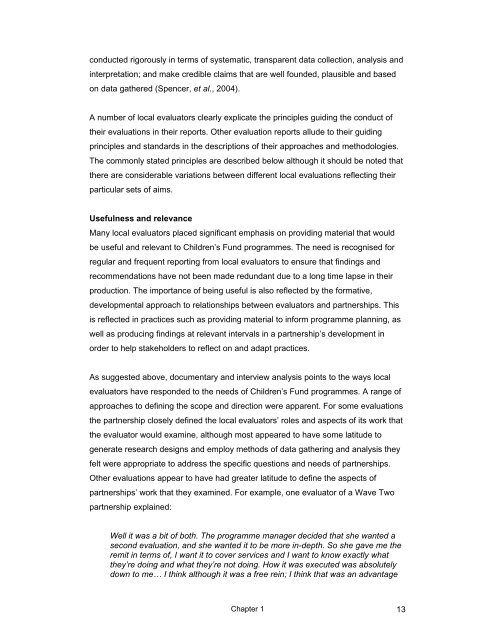Local Evaluation of Children's Services Learning from the Children's ...
Local Evaluation of Children's Services Learning from the Children's ...
Local Evaluation of Children's Services Learning from the Children's ...
- No tags were found...
You also want an ePaper? Increase the reach of your titles
YUMPU automatically turns print PDFs into web optimized ePapers that Google loves.
conducted rigorously in terms <strong>of</strong> systematic, transparent data collection, analysis andinterpretation; and make credible claims that are well founded, plausible and basedon data ga<strong>the</strong>red (Spencer, et al., 2004).A number <strong>of</strong> local evaluators clearly explicate <strong>the</strong> principles guiding <strong>the</strong> conduct <strong>of</strong><strong>the</strong>ir evaluations in <strong>the</strong>ir reports. O<strong>the</strong>r evaluation reports allude to <strong>the</strong>ir guidingprinciples and standards in <strong>the</strong> descriptions <strong>of</strong> <strong>the</strong>ir approaches and methodologies.The commonly stated principles are described below although it should be noted that<strong>the</strong>re are considerable variations between different local evaluations reflecting <strong>the</strong>irparticular sets <strong>of</strong> aims.Usefulness and relevanceMany local evaluators placed significant emphasis on providing material that wouldbe useful and relevant to Children’s Fund programmes. The need is recognised forregular and frequent reporting <strong>from</strong> local evaluators to ensure that findings andrecommendations have not been made redundant due to a long time lapse in <strong>the</strong>irproduction. The importance <strong>of</strong> being useful is also reflected by <strong>the</strong> formative,developmental approach to relationships between evaluators and partnerships. Thisis reflected in practices such as providing material to inform programme planning, aswell as producing findings at relevant intervals in a partnership’s development inorder to help stakeholders to reflect on and adapt practices.As suggested above, documentary and interview analysis points to <strong>the</strong> ways localevaluators have responded to <strong>the</strong> needs <strong>of</strong> Children’s Fund programmes. A range <strong>of</strong>approaches to defining <strong>the</strong> scope and direction were apparent. For some evaluations<strong>the</strong> partnership closely defined <strong>the</strong> local evaluators’ roles and aspects <strong>of</strong> its work that<strong>the</strong> evaluator would examine, although most appeared to have some latitude togenerate research designs and employ methods <strong>of</strong> data ga<strong>the</strong>ring and analysis <strong>the</strong>yfelt were appropriate to address <strong>the</strong> specific questions and needs <strong>of</strong> partnerships.O<strong>the</strong>r evaluations appear to have had greater latitude to define <strong>the</strong> aspects <strong>of</strong>partnerships’ work that <strong>the</strong>y examined. For example, one evaluator <strong>of</strong> a Wave Twopartnership explained:Well it was a bit <strong>of</strong> both. The programme manager decided that she wanted asecond evaluation, and she wanted it to be more in-depth. So she gave me <strong>the</strong>remit in terms <strong>of</strong>, I want it to cover services and I want to know exactly what<strong>the</strong>y’re doing and what <strong>the</strong>y’re not doing. How it was executed was absolutelydown to me… I think although it was a free rein; I think that was an advantageChapter 1 13
















